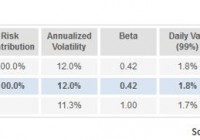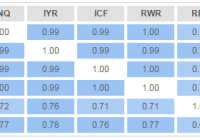First Fed Hike Puts These ETFs In Focus
Months of speculation and nail-biting hearsay about the timeline of the first rate hike in almost a decade finally ended yesterday thankfully, with neither shocks, nor surprises. The Fed pulled the trigger at long last, raising benchmark interest rates by a modest 25 bps to 0.25-0.50% for the first time since 2006, making it official that the U.S. economy is out of the woods; though still has miles to go. The step also sets the U.S. apart from other developed economies and had a great impact on the global currency market. The Fed believes that the possibility of further improvement in the labor market as well as in inflation is ripe at the current level. Muted inflation mainly due to stubbornly low oil prices has been an issue for long for the Fed. But in the 12 months through November, the core consumer price index grew 2% (matching the Fed’s target), the highest reading since May 2014 , followed by the 1.9% advancement in October. Unemployment rate fell to 5%, a more than seven-year low level. Average hourly earnings are rising of late. What’s more noteworthy was that the Fed did not move an inch from the ‘ gradual ‘ rate hike trajectory. Also, the central bank indicated that while the job market criteria is apparently accomplished, the Fed’s future focus would be on the inflation reading, which is yet to pick up at a sustained pace. Global growth worry is another factor, which is holding the Fed back from acting fast on tightening. Fed’s Projection The Fed lowered its 2015 projection for personal consumer expenditure inflation to 0.3-0.5% from 0.3-1.0% and 0.6-1.0% guided in September and June, respectively. The projections were also slashed for 2016 and 2017 from 1.5-2.4% to 1.2-2.1% and from 1.7-2.2% to 1.7-2.0%, respectively. The expectations for 2016 and 2017 real GDP growth have been ticked down to 2.0-2.7% from 2.1-2.8% guided in September (Fed’s June prediction for 2016 was 2.3-3.0%) and to 1.8-2.5% from 1.9-2.6%, respectively. However, the real GDP growth expectation for 2015 has been changed to 2.0-2.2% from 1.9-2.5% projected in September. As already discussed, unemployment was the true healer with its 2015 expectation being 5%, almost in line with the 4.9-5.2% expected in September. The coming two years will also see the same uptrend as estimates for 2016 were lowered from 4.5-5.0% to 4.3-4.9% while the same for 2017 remained unchanged at 4.5-5.0%. The notable changes were in the projection for the benchmark interest rate for 2015, 2016 and 2017. Fed’s funds rate for the longer run may be maintained at 3.0-4.0% but projection for 2015, 2016 and 2017 were changed from negative 0.1- positive 0.9% to 0.1-0.4%, from negative 0.1- positive 2.9% to 0.9-2.1% and from 1.0-3.9% to 1.9-3.4%, respectively. Market Impact However, the historic move did not mess up the market, as the investing world was prepared well ahead of the meeting. In fact, the Fed gave the global market enough time to digest the news when the central bank brought the December rate hike possibility back on to the table in October end. With no drama in the December meeting, the market is now focusing more on a sluggish rate hike, not just the hike itself. As a result, probability of a dovish rate hike trail ahead cheered equity investors almost across the globe. Even the highly vulnerable areas like emerging markets also tacked on gains during the Fed meeting. This produced a handful of surprise winners and losers post meeting. However, bonds obeyed the rule book and started diving as soon as the Fed enacted the lift-off. The two-year benchmark Treasury yield jumped 4 bps to 1.02% on December 16 – a five and a half year high. However, the yield on the 10-year Treasury note rose just 2 bps to 2.30% and yield on the long-term 30-year bonds saw a 2 bp nudge to 3.02%. All bond ETFs were in the red. Given this, we have highlighted ETF winners and losers from the Fed move: The PowerShares DB US Dollar Bullish Fund (NYSEARCA: UUP ) – Natural winner The U.S. dollar is a common winner following the lift-off. The U.S. dollar ETF UUP gained 0.04% after hours. The iShares MSCI Emerging Markets (NYSEARCA: EEM ) – Surprise Winner Emerging markets normally fall out of favor in a rising rate environment as investors dump these high-yielding, but risky, investing tools for higher yields at home. However, possibility of a gradual hike boosted the emerging market ETF EEM by about 2% on December 16. The fund added 0.2% after hours. The SPDR S&P Regional Banking ETF (NYSEARCA: KRE ) – Natural Winner The regional bank sector was pleased by the Fed decision and the resultant rise in yields, as it tends to benefit from the steepening of the yield curve. As a result, regional bank ETF KRE was up about 1% and added 0.1% after hours. The Market Vectors Gold Miners ETF (NYSEARCA: GDX ) – Surprise Winner but Potential Loser As soon as the greenback gains, commodity prices fall. Gold, one of the key precious metals, might have gained from the slower hike bet, but is likely to lose ahead. The SPDR Gold Trust (NYSEARCA: GLD ) tracking the gold bullion added over 1.2% while the largest big-cap gold mining ETF GDX added about 4% on the same day. The latter saw more gains as it often trades as a leveraged play on gold. But both lost over 0.3% and 0.6% in extended hours. The iShares Mortgage Real Estate Capped ETF (NYSEARCA: REM ) – Surprise Winner but Potential Loser Mortgage REITs perform better in a low interest rate environment. However, though high-yield REM added 3.2% yesterday, it might see a slump ahead. Original Post

